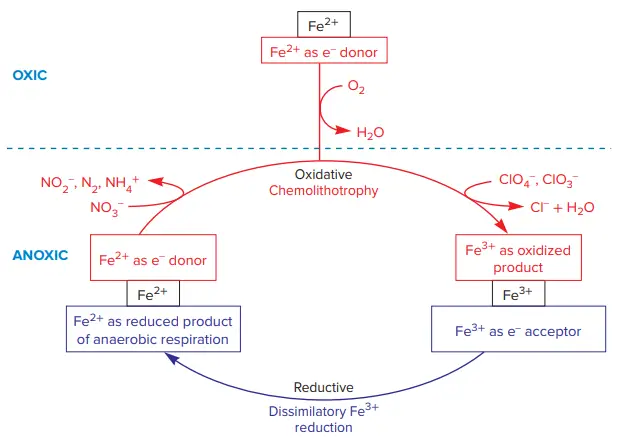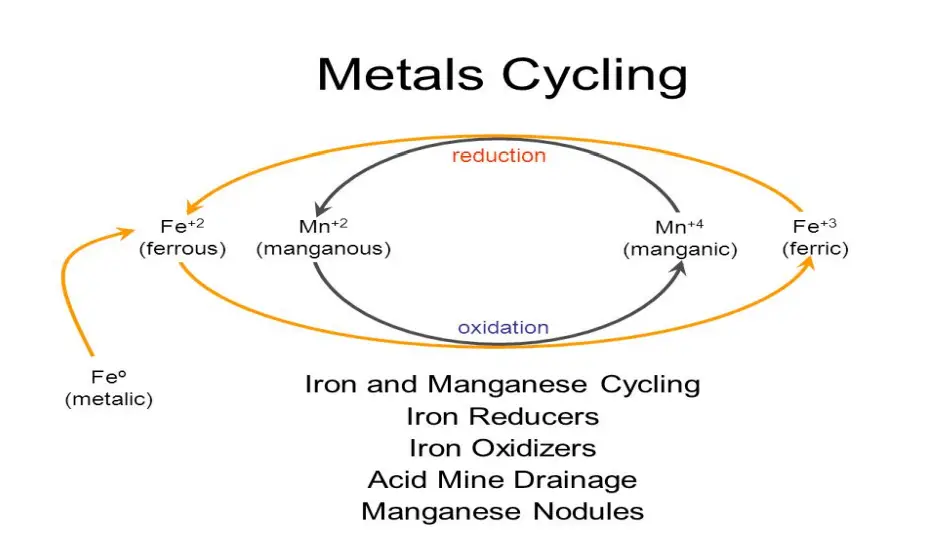Advertisements
Table of Contents
- Iron cycle (Fe) is the biogeochemical circulation of iron through the atmosphere, hydrosphere, biosphere, and lithosphere.
- In contrast to its abundance in the Earth’s crust, Fe is scarce in oxygenated surface waters.
- Iron is an essential element for primary productivity and a limiting nutrient in the High-Nutrient, Low-Chlorophyll (HNLC) zones of the Southern ocean, eastern equatorial Pacific, and subarctic Pacific.
- Iron exists in oxidation levels ranging from -2 to +7; however, on Earth it is primarily in its +2 or +3 redox state and is the most redox-active metal on the planet.
- The process through which iron cycles between its +2 and +3 oxidation levels is known as the iron cycle. This process may be fully abiotic or aided by microbes, particularly iron-oxidizing bacteria.
- The rusting of iron-bearing metals, where Fe2+ is oxidised abiotically to Fe3+ in the presence of oxygen, and the reduction of Fe3+ to Fe2+ by iron-sulfide minerals are abiotic processes.
- Microorganisms that oxidise and reduce iron perform the biological cycle of Fe2+.
- Iron is a vital micronutrient for nearly all organisms. As a member of the Nitrogenase enzyme family, it is essential for nitrogen fixation, and as part of the iron-sulfur core of ferredoxin, it enables electron transport in chloroplasts, eukaryotic mitochondria, and bacteria.
- In most locations of the planet, iron is a limiting nutrient due to the high reactivity of Fe2+ with oxygen and the limited solubility of Fe3+.
Importance
- Iron (Fe) follows a geochemical cycle similar to that of numerous other nutrients. Typically, iron is released into the soil or ocean via the weathering of rocks or by volcanic eruptions. Iron is necessary for the production of chlorophyll, and plants need adequate iron to accomplish photosynthesis.
- Iron is the most common transition metal in the biosphere and the most plentiful element on Eaith. It is a component of various cellular molecules and functions in a variety of physiological processes. Therefore, iron is a necessary micronutrient for all eukaryotes and the vast majority of prokaryotes. Prokaryotes that require iron for biosynthesis require micromolar quantities, which are typically unavailable in oxic settings with a neutral pH. To boost iron bioavailability, prokaryotes have evolved particular acquisition molecules termed siderophores.
Iron Cycle
- In the iron cycle, ferrous iron (Fe2+) is transformed into ferric iron (Fe3+). Iron is predominantly present as insoluble minerals of either oxidation state in environments with a neutral pH and abundant oxygen.
- The solubility of both reduced, ferrous iron (Fe2+) and oxidised, ferric iron (Fe3+) rises with acidification, such that below pH 4, ferrous iron exists in the aqueous form.
- Its absorption poses two obstacles for the majority of aerobic bacteria. First, although iron is a necessary element, it is typically present in extremely minute concentrations. Second, iron frequently occurs in the incorrect oxidation state for absorption: Fe3+ predominates in oxic conditions, whereas microorganisms typically take up Fe2+. The application of siderophores resolves both issues.
- Siderophores are organic molecules of low molecular weight that bind Fe3+ and facilitate their transit into the cell, where it is reduced to Fe2+.
- Iron uptake Again, dissimilatory reduction requires anaerobic respiration. During anaerobic respiration, ferric iron (Fe3+) functions as a terminal electron acceptor in dissimilatory iron reduction.
- Fe3+ is primarily found in crystalline phases (e.g., hematite and magnetite) and as a component of sediment clays in the majority of habitats.
- Certain microorganisms contribute electrons from the electron transport chain to these solid forms of Fe3+ outside of the cell. Anaerobic respiration employs the same three processes as aerobic respiration; the Order Alteromonadales contains anaerobes that utilise a variety of electron acceptors. Archaea and bacteria both possess the capacity for dissimilatory Fe3+ reduction.
- All five classes of Proteobacteria, Firmicutes, Deferribacteraceae, Acidobacteria, Thermotoga, and Thermus are also included.
- This evolutionary variety may be indicative of the age of Fe3+ decrease. It is hypothesised that life began in an environment rich in Fe2+ between 3.5 and 3.8 billion years ago.
- The photooxidation of Fe2+ to Fe3+ and H2 would have given early biological forms with an electron acceptor and an energy source, respectively.
- At the end of the Precambrian epoch, when atmospheric oxygen levels were beginning to rise, banded iron production may have been an indication of an increase in bacterial iron metabolism.
- Microbes have undergone evolution and diversification for billions of years. In addition to ferric iron (Fe3+) as a terminal electron acceptor, Aquaspirillum magnetotacticum and other magnetotactic bacteria convert extracellular iron to the mixed valence iron oxide mineral magnetite (Fe3O4) and produce intracellular magnetic compasses.
- Magnetotactic bacteria are more specifically magneto aerotactic since it is believed that they use magnetic fields to travel to the location in a bog or swamp with the optimal oxygen concentration.
- In addition, some dissimilatory iron-reducing bacteria store magnetite (Fe3O4) as an extracellular byproduct.
- Inclusions In the reduced state, lithotrophic bacteria can utilise ferrous iron (Fe2+) as an electron donor in acidic, oxic settings where it is soluble and oxygen can serve as the terminal electron acceptor.
- This has been thoroughly studied in the -proteobacterium Acidithiobacillus ferrooxidans and thermophilic crenarchaeotes of the genus Sulfalobus.
- Under oxic circumstances, a variety of microorganisms oxidise Fe2+ at neutral pH. -proteobacteria in the genera Marinobacter, Leptothrix, and Gallionella are the most thoroughly investigated.
- Under anaerobic conditions, ferrous iron can be oxidised using nitrate as the electron acceptor. Dechlorosoma suillum is an intriguing anaerobic bacterium because it oxidises Fe2+ using perchlorate (ClO4) and chlorate (ClO3) as electron acceptors.
- D. suillum may be utilised in the bioremediation (biological cleanup) of abandoned munitions installations where perchlorate is a prominent pollutant.
- This process also happens in low-oxygen aquatic sediments and may be one of the ways that huge zones of oxidised iron have formed in hypoxic conditions. Biodegradation and bioremediation utilise microorganisms to purify the environment.

Manganese and Mercury Cycles
- Similar to the iron cycle, the manganese cycle consists of the change of the reduced form, manganous ion (Mn2+), into the oxidised species, MnO2 (equal to manganic ion [Mn4+]).
- In hydrothermal vents, peat bogs, and stratified lakes, this happens at the oxic-anoxic interface. Diverse bacteria possess the ability to utilise Mn2+ as an electron donor with oxygen or nitrate as the terminal electron acceptor.
- Using MnO2 as an electron acceptor, Shewanella spp., Geobacter spp., and other chemoorganotrophs can carry out the complementing manganese reduction process.
- The mercury cycle displays numerous methylation-capable metal properties.
- Historically, mercury compounds were frequently utilised in industrial operations. The accumulation of inorganic mercury in anoxic sediments is methylated by anaerobic bacteria of the genus Desulfovibrio, iron-reducing bacteria, and methanogens.
- Methylated mercury forms are volatile and lipid-soluble, and biomagnification causes mercury concentrations to grow with each link in the food web.
- Humans who consume fish containing high levels of methylation mercury can develop serious neurological problems, particularly in youngsters.
- This risk was tragically shown in the 1950s in Japan, when mercury poisoning on a huge scale occurred in the Minamata Bay region as a result of industrial mercury discharge into the marine environment.

Couple Iron-Manganese cycle
- Mn can precipitate at high pH, reducing Mn availability; hence, deficits are most likely to arise in soils with high pH. (calcareous soils or over-limed soils).
- Manganese is primarily accessible in soils with a pH between 5 and 6.5. The link between the changes of iron and manganese in nature and the cycling of these and other physiologically active elements.
- The oxidation and reduction of iron and manganese in natural environments are facilitated to a great part by microbial catalysis, although abiotic transformations are equally significant and may compete with biological processes.
- Iron and manganese are typically small components of rock-forming silicate minerals in the Earth’s crust, such as olivine, pyroxenes, and amphiboles.
- The continental crust has an abundance of iron, 4.3% by mass. Manganese is the second most abundant redox-active metal, with a crustal abundance 50 times lower than iron.
- Iron and manganese share numerous commonalities in terms of geochemistry and microbiology. Significantly contribute to the oxidation of reduced iron and manganese are microorganisms.
- Dissimilatory iron-and manganese-reducing microorganisms facilitate the reduction of Fe (III) to Fe (II) and of Mn (III) or Mn (IV) to Mn (II). In aquatic conditions, microbial manganese and iron reduction also occurs.
- For microbial iron or manganese reduction to survive in normal aquatic habitats with a near neutral pH, three essential criteria must be met: the absence of oxygen, the presence of electron donors, and oxidised manganese or iron in the right form.
- The first is a direct quantification of changes in Fe(III) or Fe(II) pools throughout incubations of sediment.
- The second method determines dissimilatory iron and manganese reduction rates by comparing the depth distribution of total carbon oxidation, based on the formation of dissolved inorganic carbon, to observed sulphate reduction rates.

References
- Liu, Fanghua & CHEN, Lei & Zheng, Shiling & Zhang, Hongxia & LI, Ying. (2016). The Role of Microorganisms in the Geochemical Iron Cycle. SCIENTIA SINICA Vitae. 46. 1069-1078. 10.1360/N052016-00064.
- http://www.geography4kids.com/files/cycles_iron.html
- https://www.rnlkwc.ac.in/pdf/study-material/microbiology/Iron%20and%20Manganese%20cycle.pdf
- https://scope.dge.carnegiescience.edu/SCOPE_17/SCOPE_17_2.2_Chapter6_93-112.pdf
